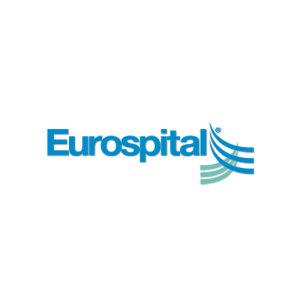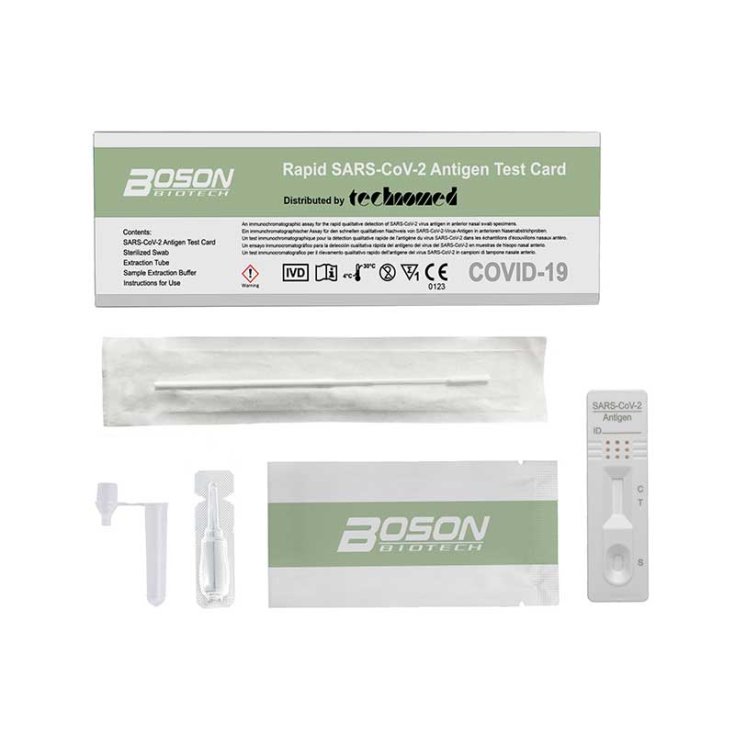Boson Biotech Selftest Antigenic Rapid For Covid-19 1 Piece

- Brand: EUROSPITAL SpA
- Product Code: 982473771
- EAN: 6921963712226
- Availability: In 10 - 14 Days
- Purchase 3 items for 3.25€ each
- Purchase 4 items for 3.19€ each
- Purchase 5 items for 3.12€ each
Boson Biotech Selftest Rapid Antigenic for Home Use for Covid-19
Rapid Nasal Swab is the first Rapid Antigenic Self-Test for the detection of a possible Covid-19 infection, completely do-it-yourself and perfect for home use comfortably at home .
Boson Biotech is a medical device registered with the Ministry of Health no. 2089498, CE 0123 marked, Certificate N °: V90613170006 Rev.00.
The SARS-CoV-2 Boson Rapid Antigen Test is a single-step immunochromatographic in vitro test. This test is designed for the rapid qualitative detection of SARS-CoV-2 coronavirus antigens on anterior (anterior part of the nose) nasal swab specimens from individuals with suspected COVID-19 infection within the first seven days of symptom onset. The SARS-CoV-2 Antigen Rapid Test Cassette should not be used as the sole basis for diagnosis or to rule out a SARS-CoV-2 infection. Children under 14 must be supervised by an adult.
How to do the Rapid Self Test for Sars Cov-2
1. Open the extraction solution, holding it away from your face and being careful not to spill the liquid.
2. Pour the entire contents of the extraction solution into the extraction tube avoiding contact between the two containers
3. Locate the soft tip of the swab inside the sealed pouch. Open the sachet from the opposite side of the soft tip and carefully remove the swab.
4. Carefully insert the swab into one nostril. The tip of the swab should be inserted at least 2.5cm deep from the edge of the nostril.
Rotate the swab along the mucosa inside the nostril to ensure that both mucus and cells are collected. Rotate the swab 3-4 times. Leave the swab in the nostril for about 10 seconds. Repeat the procedure with the same swab in the other nostril.
Warning : this operation can be unpleasant. Do not insert the tampon deeper if you feel severe resistance or pain.
5. Insert the swab into the extraction tube. Now rotate the swab three to five times, and leave it in the solution for about 1 minute.
6. Press the extraction tube with your fingers while withdrawing the swab trying to drop as much solution as possible into the tube and discard the swab.
7. Place the cap with the dropper on the extraction tube.
8. Leave kit components at room temperature before testing. Open the pouch and remove the test cassette. Place the test cassette on a flat, straight surface. After opening the test cassette should be used immediately.
9. Rotate the extraction tube and pour 3 drops of the sample onto the well by gently squeezing the extraction tube. Caution: Avoid the formation of bubbles in the extraction tube.
10. The result is displayed after 15-20 minutes. Warning: after more than 20 minutes the result may be wrong. The product used can be disposed of in normal household waste in accordance with applicable local regulations.
Warnings
1. Read these instructions carefully.
2. Do not use the product after the expiration date.
3. Do not use the product if the pouch is damaged or the seal is broken.
4. Store the test at 4 to 30 ° C in the original sealed pouch. Do not freeze.
5. The product must be used at room temperature (15 ° C to 30 ° C). If the product has been stored in a colder environment (temperature below 15 ° C), leave it at normal room temperature for 30 minutes before use.
6. Treat all specimens as potentially infectious.
7. Inappropriate or inaccurate specimen collection, storage, and transport may lead to inaccurate test results.
8. Use the swabs provided in the package to ensure optimal test performance.
9. Correct sampling is of paramount importance for performing the test. Be sure to collect enough sample material for analysis (nasal secretions) with the swab, especially for the nasal sample collection in the front.
10. Blow your nose several times before taking the sample.
11. Samples should be examined as soon as possible after collection.
12. Introduce the drops of sample to be analyzed into the well (S) only.
13. Too many or too few drops of the Extraction Solution can make the test result invalid or incorrect.
14. Children under 14 must be supervised by an adult.
15. The test is to be used only for the qualitative detection of SARS-CoV-2 virus antigens in anterior nasal (anterior part of the nose) swab specimens. The exact concentration of SARS-CoV-2 virus antigens cannot be determined with this test.
16. Correct sampling is essential. Failure to follow the procedure can lead to inaccurate test results. Inadequate specimen collection, storage, freezing and thawing can lead to inaccurate test results.
17. If the viral load of the sample is below the detection limit of the test, the test may give a negative result.
18. As with all diagnostic tests, a final clinical diagnosis should not be based on the result of a single test, but should be made by the physician following evaluation of all clinical and laboratory findings.
19. Regardless of SARS-CoV-2, a negative result does not rule out a viral infection and should be confirmed by molecular diagnostics if COVID-19 is suspected.
20. A positive result does not exclude packaging with other pathogens.
21. The SARS-CoV-2 Rapid Antigen Test can detect the presence of both viable and non-viable SARS-CoV-2 material. Performance of the SARS-CoV-2 Rapid Antigen Test is viral load dependent and may not correlate with other diagnostic methods performed on the same specimen.
22. Users should test samples as quickly as possible after collection and in any case within two hours of collection.
23. The sensitivity of nasal or oropharyngeal swabs may be less than that of nasopharyngeal swabs. The nasopharyngeal swab method should be performed by healthcare professionals.
24. Monoclonal antibodies that have undergone minor amino acid changes in the target epitope region may fail to detect or less sensitively detect the SARS-CoV-2 virus.
25. The amount of antigen in a sample may decrease with increasing disease duration. Samples taken after the 5th-7th day of illness are more likely to be negative than an RT-PCR test.
26. The kit was verified with the swabs provided. Using other swabs can lead to false negative results.
27. The validity of the SARS-CoV-2 Rapid Antigen Test has not been proven for identification / confirmation of tissue culture isolates and should not be used in this function.
28. The cross-reactivity of the test cassette was evaluated by testing viruses and other microorganisms. Definitive concentrations of viruses and other microorganisms are documented in the Cross-Reactivity study. The viruses and other microorganisms listed there, with the exception of the human SARS coronavirus, have no influence on the test cassette test results. Positive test results do not exclude packs with other pathogens. Positive results can occur in case of SARS-CoV-2 infection
How to interpret the results of the Rapid Self Test for Sars-Cov2
Positive : If two colored lines, a control line (C) and a line in the test area (T) appear within 15-20 minutes, the test is valid and positive.
Negative : If within 15-20 minutes a colored line appears in the control area (C) and no colored line is seen in the test area (T), the test is negative.
Invalid : If no lines appear in the control area (C) within 15-20 minutes, the test is invalid. Repeat the test from the beginning.
For more information read the instructions contained within the test.
Package Contents
1x SARS-CoV-2 Antigen Test Cassette (sealed foil pouch)
1x Sterile swab
1x Extraction tube
1x Extraction Solution
1x Instructions for use (this leaflet)
1x Test tube holder
Registered with the Ministry of Health
Min. Sal. No. 2089498
CE 0123 marking,
Certificate N °: V90613170006 Rev.00
of 01/04/2021
Diagnostic sensitivity: 96.77
Diagnostic specificity: 99.20


